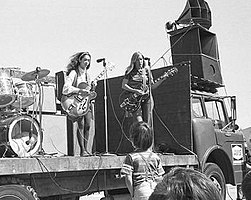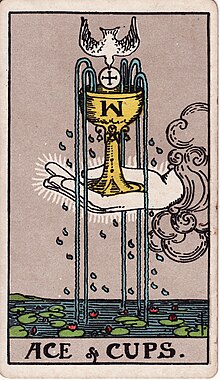The Ace of Cups
The Ace of Cups | |
|---|---|
 Denise Kaufman and Mary Ellen Simpson | |
| Background information | |
| Origin | San Francisco, California, U.S. |
| Genres | Rock, rhythm and blues, folk rock |
| Years active | 1967–1972 |
| Past members | Mary Gannon Marla Hunt Mary Ellen Simpson Diane Vitalich Denise Kaufman — Joe Allegra Jerry Granelli Noel Jewkes Lolly Lewis |
The Ace of Cups was an American rock band formed in San Francisco in 1967. It has been described as one of the first all-female rock bands.[1][2][3][4]
The members of the Ace of Cups were Mary Gannon (bass), Marla Hunt (organ, piano), Denise Kaufman (guitar, harmonica), Mary Ellen Simpson (lead guitar), and Diane Vitalich (drums). Lead vocals were sung by all members of the band except Vitalich, and all five sang backup. The songwriting, too, was divided among the band members.[5]
Background
Gannon was born in New York and moved to San Francisco in the early 1960s. She played bass for a short while in a band called Daemon Lover. Hunt, who had grown up in Los Angeles, had been playing the piano since she was three. Like Gannon, she also moved to San Francisco in the early 1960s. Hunt was introduced to Gannon through a mutual friend, and Gannon suggested that they form an all-female rock band.[6]
Simpson was from Indio, California. She began playing the guitar when she was 12. Like Gannon and Hunt, she moved to San Francisco in the early 1960s. Vitalich, a San Francisco native, was a veteran of several bands. She once played drums with Bill Haley and the Comets. Simpson and Vitalich joined Gannon and Hunt's band around the same time.[7]
The last woman to join the Ace of Cups was Kaufman. She also had the most colorful background of the group. Kaufman had been arrested during the Free Speech Movement at Berkeley,[8] and she was involved with Ken Kesey and the Merry Pranksters (who dubbed her "Mary Microgram").[5] In a 1995 interview, Hunt remembered her first impression of Kaufman:
I'll never forget when she walked in. She's wearing cowboy boots, a very short skirt, a wild fur coat and a fireman's hat. Her hair's stickin' straight out on the side. She's got these big glasses and this big guitar case—she's like 5'3" and it's almost as big as she is. Even in San Francisco she stood out.[9]

The band was named the Ace of Cups by their manager, astrologer Ambrose Hollingworth, after the Ace of Cups tarot card, which shows a cup with five streams of water. He told the women that the streams represented the five of them, and that they should "go with the flow" to see where the music would take them.[10]
Career
The Ace of Cups made their debut in the early spring of 1967. In late June, Jimi Hendrix invited the band to open for him at a free concert in Golden Gate Park.[11] In London that December, Hendrix told Melody Maker about some of the "groovy sounds" he had heard that year, "like this girl group, Ace of Cups, who write their own songs and the lead guitarist is hell, really great".[12]
In San Francisco, the Ace of Cups—whose new manager, Ron Polte, also managed Quicksilver Messenger Service—were playing regularly, headlining at smaller clubs such as The Matrix and performing as the opening act at larger venues such as the Avalon Ballroom and the Fillmore.[13] In mid-1968, the band appeared on a local television program, West Pole, along with San Francisco legends Jefferson Airplane and the Grateful Dead.[14] In 1969, they opened for The Band's first concert as The Band along with The Sons of Champlin.[15]
Several record companies were interested in signing the Ace of Cups, but Hollingworth and Polte felt the band was worth more than the record companies were offering. Also, some of the band members were concerned that a record contract might require the band to tour, and they were worried that family pressures would interfere. Consequently, the Ace of Cups never made any professional recordings of their own,[16] although they did contribute vocals to Jefferson Airplane's Volunteers and albums by Mike Bloomfield and Nick Gravenites.[5]
Decline
Several factors led to the decline of the Ace of Cups. Some of the band members were frustrated at the group's lack of commercial success. Others were interested in other pursuits. Several members had children and found it difficult to balance motherhood and a musical career.[17]
In the early 1970s, several men joined the band to replace the women who had left. Kaufman was the last remaining member from the original line-up when the band folded in 1972.[18]
CD and DVD
In 2003, Ace Records released It's Bad for You But Buy It!, a CD of "rehearsals, demos, TV soundstages, and in-concert tapes" of the Ace of Cups. The CD was generally well-received.[4][5][19]
The band's performances on the 1968 television program West Pole were released on DVD in 2008 by Eagle Vision.[20]
See also
Notes
- ^ Gleason, Toby (2008). Go Ride the Music / West Pole (Media notes). Eagle Vision.
{{cite AV media notes}}:|format=requires|url=(help); Unknown parameter|publisherid=ignored (help) - ^ Lindblad, Peter (September 23, 2008). "Psychedelic '60s bands on DVD". Goldmine. Archived from the original on March 23, 2009. Retrieved May 1, 2009.
- ^ Palao, Alec (2003). It's Bad for You But Buy It! (Media notes). Big Beat. p. 3.
{{cite AV media notes}}:|format=requires|url=(help); Unknown parameter|bandname=ignored (help); Unknown parameter|notestitle=ignored (help); Unknown parameter|publisherid=ignored (help) - ^ a b Robinson, Bruce (March 25, 2009). "Rock 'n' Role Models". Metro. Retrieved May 1, 2009.
- ^ a b c d Lundborg, Patrick (2005). "Denise Kaufman & The Ace of Cups". Shindig! (5). Retrieved May 1, 2009.
- ^ Palao. It's Bad for You But Buy It! (Media notes). pp. 4–5.
{{cite AV media notes}}: Unknown parameter|notestitle=ignored (help) - ^ Palao. It's Bad for You But Buy It! (Media notes). pp. 6–7.
{{cite AV media notes}}: Unknown parameter|notestitle=ignored (help) - ^ Palao. It's Bad for You But Buy It! (Media notes). p. 7.
{{cite AV media notes}}: Unknown parameter|notestitle=ignored (help) - ^ Frolik, Joe (August 6, 1995). "Always Live; Never on Wax". The Plain Dealer. Retrieved May 1, 2009.
- ^ Palao. It's Bad for You But Buy It! (Media notes). p. 10.
{{cite AV media notes}}: Unknown parameter|notestitle=ignored (help) - ^ Palao. It's Bad for You But Buy It! (Media notes). pp. 10–11.
{{cite AV media notes}}: Unknown parameter|notestitle=ignored (help) - ^ Fallon, B. P. (December 23, 1967). "Jimi Hendrix: The Pop Sound of the Year". Melody Maker. p. 14.
- ^ Palao. It's Bad for You But Buy It! (Media notes). pp. 12–13.
{{cite AV media notes}}: Unknown parameter|notestitle=ignored (help) - ^ Swenson, John (2008). Go Ride the Music / West Pole (Media notes). Eagle Vision.
{{cite AV media notes}}:|format=requires|url=(help); Unknown parameter|publisherid=ignored (help) - ^ Gleason, Ralph J. (May 1969). "The Band at Winterland". Rolling Stone. Retrieved January 31, 2011.
- ^ Palao. It's Bad for You But Buy It! (Media notes). pp. 15–17.
{{cite AV media notes}}: Unknown parameter|notestitle=ignored (help) - ^ Palao. It's Bad for You But Buy It! (Media notes). pp. 17–18.
{{cite AV media notes}}: Unknown parameter|notestitle=ignored (help) - ^ Palao. It's Bad for You But Buy It! (Media notes). p. 18.
{{cite AV media notes}}: Unknown parameter|notestitle=ignored (help) - ^ Unterberger, Richie. "It's Bad for You But Buy It!". Allmusic. Retrieved May 1, 2009.
- ^ Perry, Shawn. "DVD Review: Go Ride the Music and West Pole". Vintage Rock. Retrieved November 14, 2009.
Further reading
- Atlas, Jacoba (November 6, 1971). "There Aren't Many Girls in Hard Rock, But a New Day (and Attitude) Is Dawning". Billboard: p. RN-20. Retrieved May 1, 2009.
{{cite journal}}:|page=has extra text (help)
